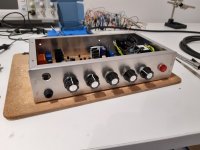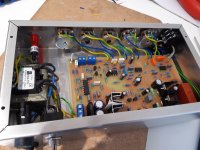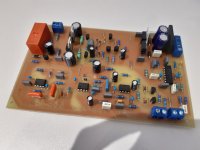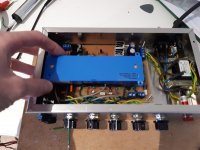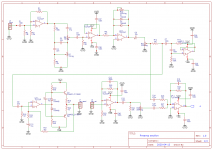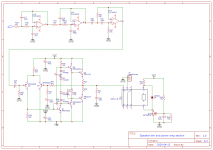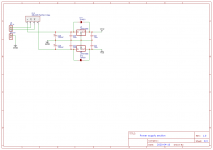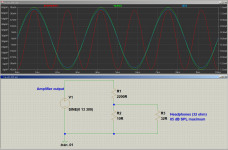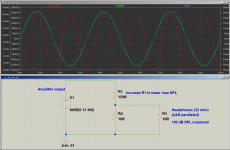Hi,
I've been working on building a headphone guitar amp and wanted to share my progress as well as a few problems I'm having.
The design is pretty straightforward with pre-overdrive EQ (AC30 tone stack), diode clipping overdrive and spring reverb. It also includes a speaker simulator that I got from this website:
Celestion G12H Speaker Sim - Distorque
The power amp is a basic discrete design using TIP31C/TIP32C output transistors and simple diode biasing. The preamp uses TL072 dual op-amps throughout and uses an op-amp with a buffered output stage for the reverb driver, based on Rod Elliot's advice. It was originally wired for current drive but I found that I preferred the sound with voltage drive.
The reverb was a pain to get sounding right due to it being such a small tank. it is driven relatively high to reduce the makeup gain required. I found that there was a very strong resonance at 400Hz, hence the notch filter before the driver circuit.
There is a switch on-delay circuit using a relay and MOSFET but no DC protection. Strangely (perhaps) it sounds best with very cheap headphones so I'm not too bothered about the small possibility of damaging them.
It's working okay in general but I do have a few problems that need sorting.
Firstly, the volume control is not very good. It remains too quiet for most of its travel and then dramatically increases in volume right near the maximum. There is only a small amount of useful range. I wondered if changing the value would help as, when it was on the breadboard, I was using a 100k linear pot. It is now 220k log. I also wondered about adding a treble bleed resistor between the input and the wiper.
The second, and probably most major, problem is the hum induced in the reverb tank. My plan was to mount the tank to the lid of the enclosure with the pickup end furthest from the transformer. However, in this position there is an unacceptable level of hum. Rotating the tank on its axis reduces the hum considerably but it is then not possible to secure it to the lid, or even fit the lid on top. I also considered adding a high pass filter to the tank output to reduce the 100Hz component.
Finally, there is a reasonable level of hiss on the output. It's not excessive but it's enough to be annoying. I wondered if reducing the power amp gain and increasing the gain at the summing amp stage might help.
If anyone has any suggestions then that would be fantastic! I've included pictures of the amp and also the schematic.
Thanks in advance!
James

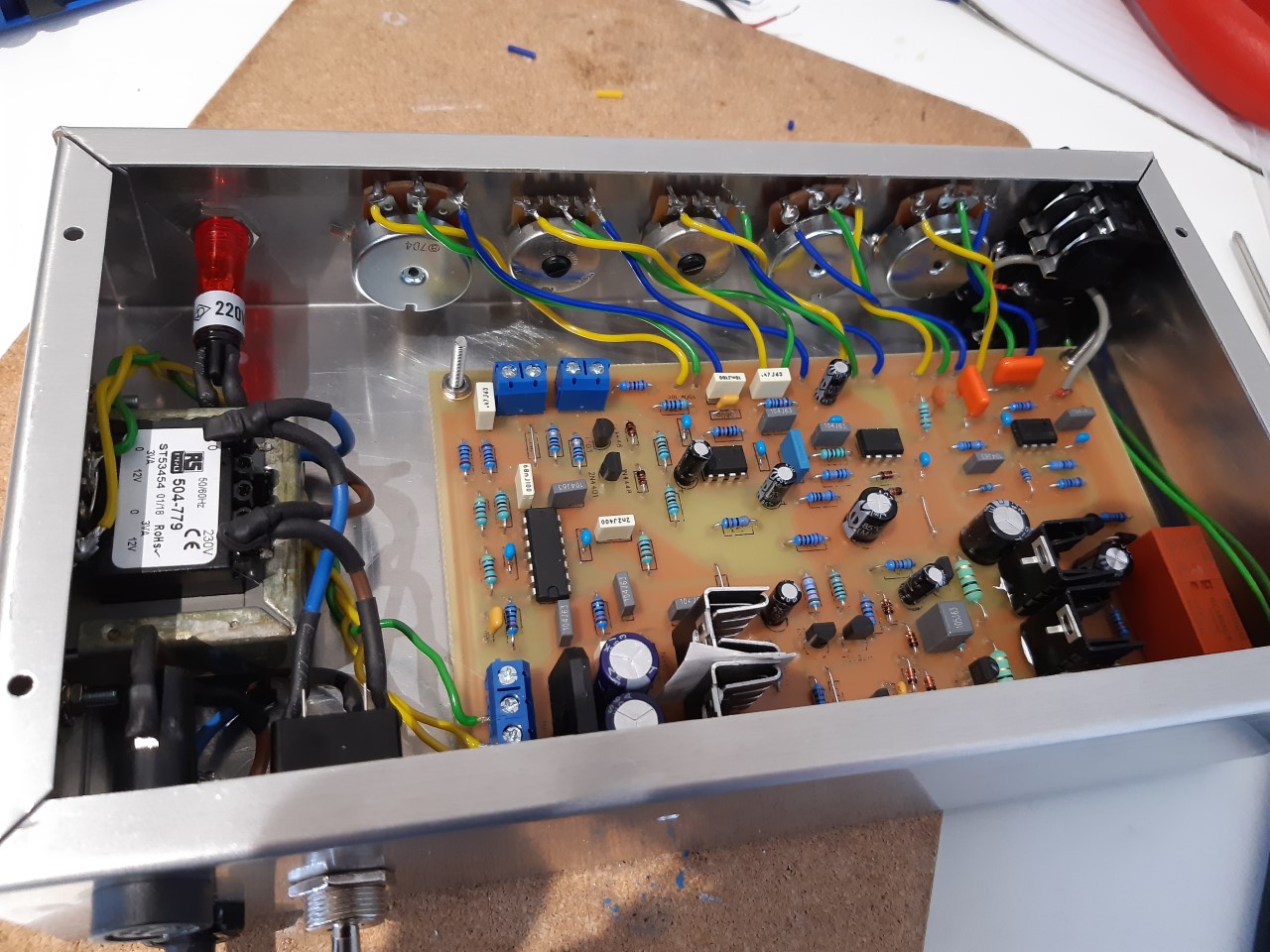
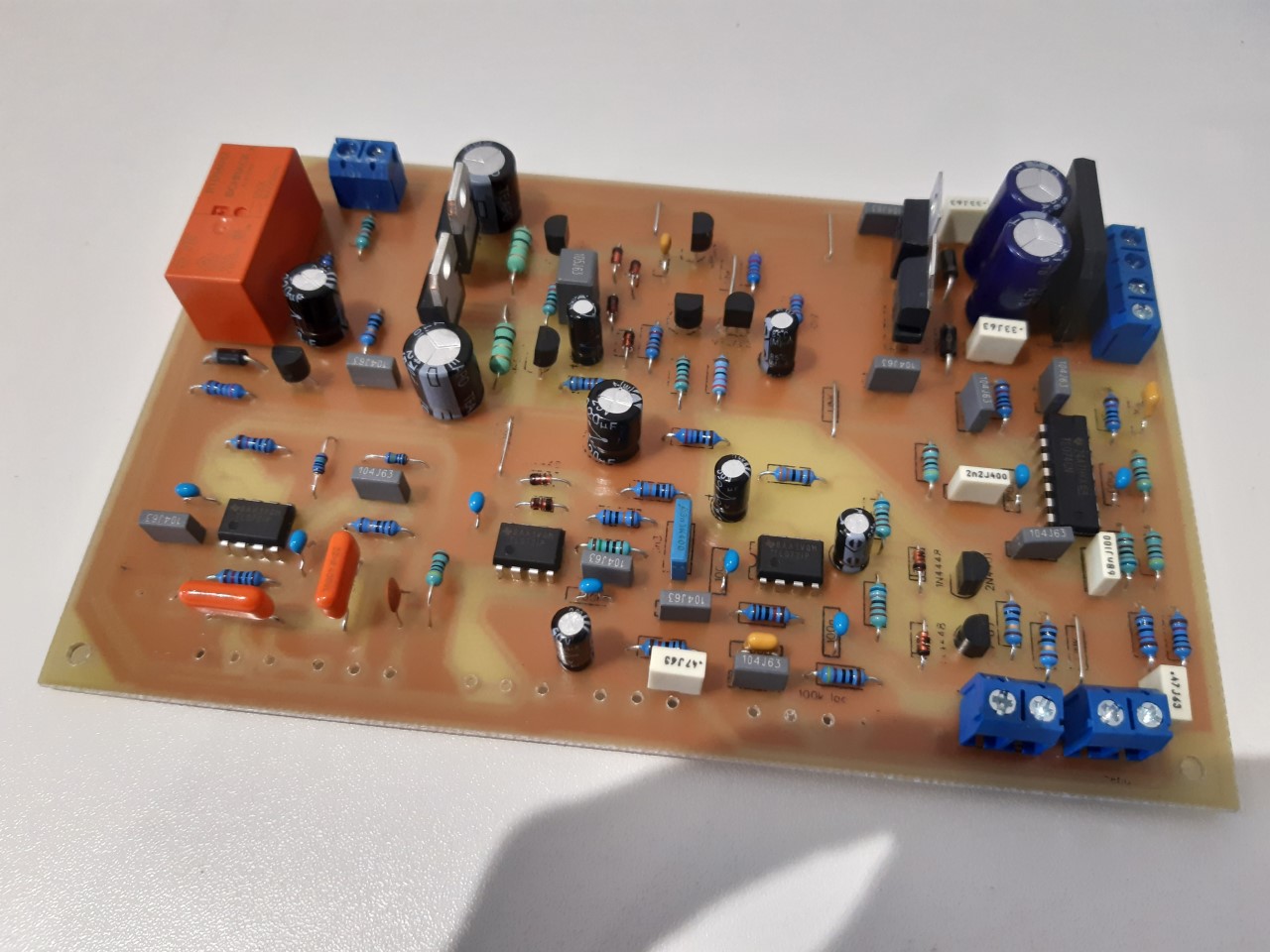
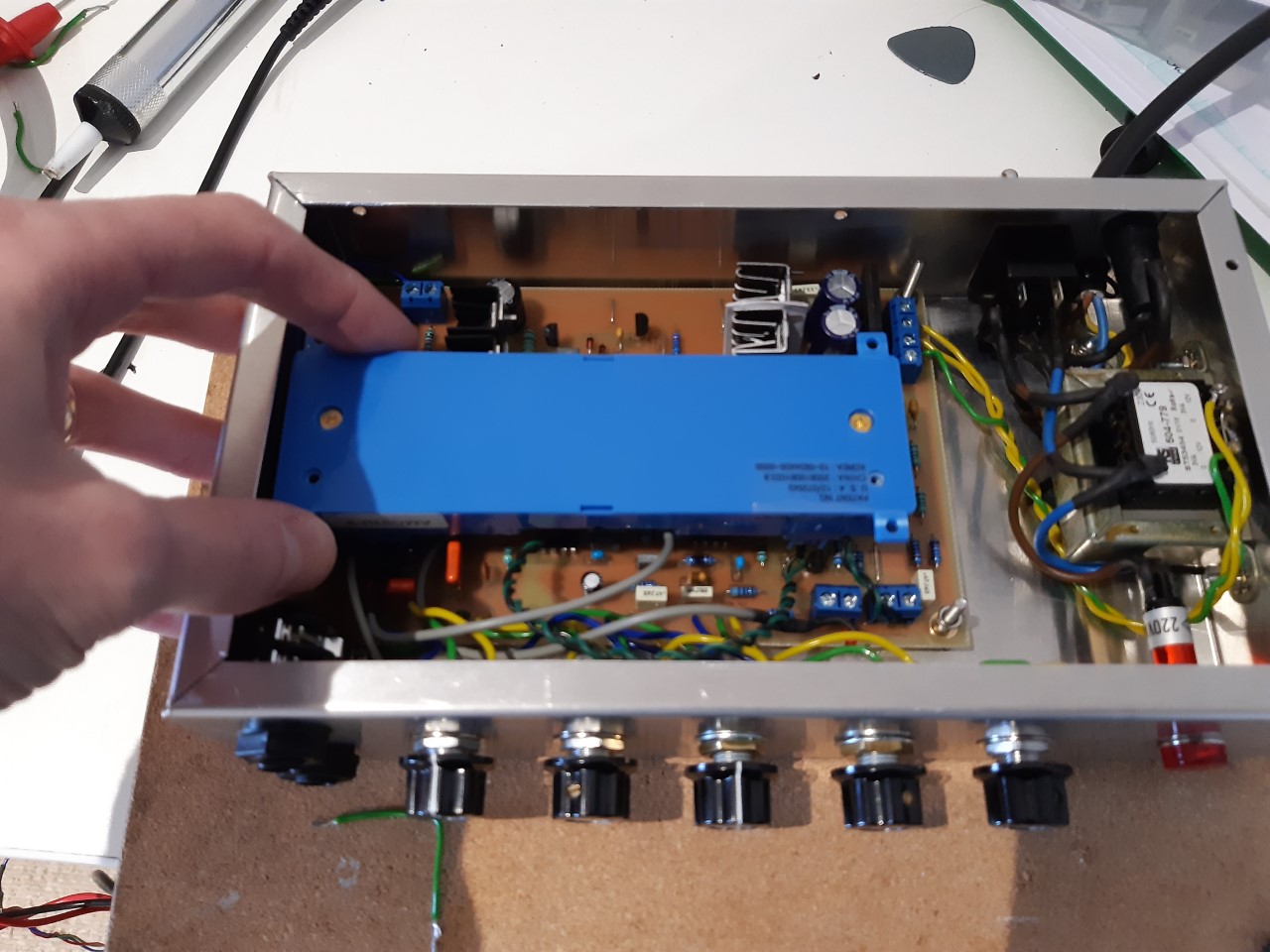
I've been working on building a headphone guitar amp and wanted to share my progress as well as a few problems I'm having.
The design is pretty straightforward with pre-overdrive EQ (AC30 tone stack), diode clipping overdrive and spring reverb. It also includes a speaker simulator that I got from this website:
Celestion G12H Speaker Sim - Distorque
The power amp is a basic discrete design using TIP31C/TIP32C output transistors and simple diode biasing. The preamp uses TL072 dual op-amps throughout and uses an op-amp with a buffered output stage for the reverb driver, based on Rod Elliot's advice. It was originally wired for current drive but I found that I preferred the sound with voltage drive.
The reverb was a pain to get sounding right due to it being such a small tank. it is driven relatively high to reduce the makeup gain required. I found that there was a very strong resonance at 400Hz, hence the notch filter before the driver circuit.
There is a switch on-delay circuit using a relay and MOSFET but no DC protection. Strangely (perhaps) it sounds best with very cheap headphones so I'm not too bothered about the small possibility of damaging them.
It's working okay in general but I do have a few problems that need sorting.
Firstly, the volume control is not very good. It remains too quiet for most of its travel and then dramatically increases in volume right near the maximum. There is only a small amount of useful range. I wondered if changing the value would help as, when it was on the breadboard, I was using a 100k linear pot. It is now 220k log. I also wondered about adding a treble bleed resistor between the input and the wiper.
The second, and probably most major, problem is the hum induced in the reverb tank. My plan was to mount the tank to the lid of the enclosure with the pickup end furthest from the transformer. However, in this position there is an unacceptable level of hum. Rotating the tank on its axis reduces the hum considerably but it is then not possible to secure it to the lid, or even fit the lid on top. I also considered adding a high pass filter to the tank output to reduce the 100Hz component.
Finally, there is a reasonable level of hiss on the output. It's not excessive but it's enough to be annoying. I wondered if reducing the power amp gain and increasing the gain at the summing amp stage might help.
If anyone has any suggestions then that would be fantastic! I've included pictures of the amp and also the schematic.
Thanks in advance!
James
Attachments
Noisy Headphone Amp for Guitar
I have just done a quick scan of your schematic. You can probably reduce the hiss quite a bit by reducing the 1MEG input resistors on the TL072 amplifier stages and using larger coupling capacitors. I expect that you are hearing a fair amount of Johnson noise.
Re the volume control: the wiper is actually seeing a fairly low input resistance on the gyrator stage. This will affect the overall transfer function of the potentiometer in the way that you describe. You should either raise the input resistance or decrease the pot value.
I have just done a quick scan of your schematic. You can probably reduce the hiss quite a bit by reducing the 1MEG input resistors on the TL072 amplifier stages and using larger coupling capacitors. I expect that you are hearing a fair amount of Johnson noise.
Re the volume control: the wiper is actually seeing a fairly low input resistance on the gyrator stage. This will affect the overall transfer function of the potentiometer in the way that you describe. You should either raise the input resistance or decrease the pot value.
Unfortunately, electric guitar pickups need a minimum 1 meg input impedance from the amplifier, so reducing this resistor is a bad idea.You can probably reduce the hiss quite a bit by reducing the 1MEG input resistors on the TL072 amplifier stages and using larger coupling capacitors.
However, using a larger input coupling capacitor, or even eliminating it altogether (if your guitar provides an internal path to ground through its volume control, as most do), is still a good move. When the guitar is plugged in, its internal impedance shunts that 1M input resistor, and so reduces thermal noise.
-Gnobuddy
> reduce the hiss quite a bit by reducing the 1MEG input resistors on the TL072 amplifier stages
The one at the input is "bypassed" by the guitar, so the 1Meg is a very 2nd-order hiss; and likewise downstream due to 1st stage voltage gain.
I agree that a full re-think might chew 1db or 2dB of hiss out, but it shouldn't stink.
Does tank orientation and jack grounding matter on those tiny plastic tanks? I've never touched one, I don't know.
The one at the input is "bypassed" by the guitar, so the 1Meg is a very 2nd-order hiss; and likewise downstream due to 1st stage voltage gain.
I agree that a full re-think might chew 1db or 2dB of hiss out, but it shouldn't stink.
Does tank orientation and jack grounding matter on those tiny plastic tanks? I've never touched one, I don't know.
The was an actual spring reverb in the bright-red Fender Frontman 25R I owned for a little while. The reverb "tank" was a scrap of plastic with a wee little fully exposed spring. From memory, it was about the size of a pack of chewing gum....tiny plastic tanks...
It didn't sound too bad at fairly low reverb levels. Turn it up too high, and all manner of bizarre sounds emerged.
-Gnobuddy
Thanks for the suggestions. I've had a play around with it and made a few adjustments. I tested the noise with the power amp input grounded and it disappeared entirely so it's definitely all preamp noise. Grounding the input to the speaker simulator stage made little difference so I suspect that most of the noise is coming from this stage. Bringing up the volume control does introduce a bit more, slightly lower pitched, hiss which I imagine is the Johnson noise that's been mentioned so I'll look into that.
I have swapped the 1k resistor in the power amp feedback loop with a 2k2 and replaced the 1k feedback resistor in the summing stage with a 2k2. This has helped considerably. I don't want to increase the feedback too much on the power amp in case this causes stability issues. Making the resistor swap on the power amp had the added bonus of reducing the DC offset significantly. I'm not entirely sure why though!
I have changed the volume pot from 220k log to 10k log and this has fixed the volume problem entirely. I will do the same for the reverb return level pot as this has the same issue. I realise this will mean adjusting the high pass filter on the recovery amp's output.
In terms of the reverb, there seems to be very little information available on the tank except from input and output impedances. I can't find a proper datasheet anywhere. There is no continuity between the input and output grounds so both are required to be connected. The tank is made of plastic with no foil shielding or similar. The orientation makes a big difference, with the hum being reduced from unacceptable to almost non existent when the tank is rotated by around 30 degrees. The problem is that it then doesn't fit in the box. The obvious solution would be to keep the tank straight and rotate the transformer but there isn't enough wiggle room for the transformer. It may be possible to rotate both the tank and the transformer in opposite directions to achieve the desired angular difference so I'll look into that.
The reverb was always going to be an issue I think. I know that guitar amps typically have the tank mounted at the base or side of the cabinet, far away from the mains transformer but I do have one amp (HH IC100) and a PA amplifier where the reverb tank is mounted inside the chassis, fairly close to the transformer so I thought it should be manageable.
Anyway, thanks for all your replies so far! They've been very useful.
Thanks,
James
I have swapped the 1k resistor in the power amp feedback loop with a 2k2 and replaced the 1k feedback resistor in the summing stage with a 2k2. This has helped considerably. I don't want to increase the feedback too much on the power amp in case this causes stability issues. Making the resistor swap on the power amp had the added bonus of reducing the DC offset significantly. I'm not entirely sure why though!
I have changed the volume pot from 220k log to 10k log and this has fixed the volume problem entirely. I will do the same for the reverb return level pot as this has the same issue. I realise this will mean adjusting the high pass filter on the recovery amp's output.
In terms of the reverb, there seems to be very little information available on the tank except from input and output impedances. I can't find a proper datasheet anywhere. There is no continuity between the input and output grounds so both are required to be connected. The tank is made of plastic with no foil shielding or similar. The orientation makes a big difference, with the hum being reduced from unacceptable to almost non existent when the tank is rotated by around 30 degrees. The problem is that it then doesn't fit in the box. The obvious solution would be to keep the tank straight and rotate the transformer but there isn't enough wiggle room for the transformer. It may be possible to rotate both the tank and the transformer in opposite directions to achieve the desired angular difference so I'll look into that.
The reverb was always going to be an issue I think. I know that guitar amps typically have the tank mounted at the base or side of the cabinet, far away from the mains transformer but I do have one amp (HH IC100) and a PA amplifier where the reverb tank is mounted inside the chassis, fairly close to the transformer so I thought it should be manageable.
Anyway, thanks for all your replies so far! They've been very useful.
Thanks,
James
If all else fails, there's this: ammoon Spring Reverb Mini Single Guitar Effect Pedal True Bypass (Spring Reverb): Amazon.co.uk: Musical InstrumentsThe reverb was always going to be an issue I think.
To bring up an entirely different issue: I'm very concerned about the future of your hearing.
The nutshell version: a headphone amp that can spit out +/-13 volts is incredibly dangerous to the future of your hearing.
The details: most of the headphones I've run across will spit out 100 dB SPL (loud enough to damage hearing) at your ear with 1 mW of input power. Thirty-two ohms is a fairly typical contemporary headphone impedance. 85 dB SPL is a widely-used international standard for how much abuse your ears can take for a few hours without permanent damage.
Put those numbers together, and typical headphones only need 50 mV peak (volts) to generate 85 dB, the loudest sound that (may) be safe to listen to for a few hours a day.
Going the other way, your amp is designed with +/- 15 volt rails, and the output can probably swing to about +/- 13 volts, for a maximum output of 26 volts peak to peak. That would drive 2.64 watts into a pair of 32 ohm headphones, and for the few seconds before the headphone voice coils burned out, that would correspond to a nominal SPL of 134 dB at your ears.
An SPL of 134 dB, according to references I looked up, is loud enough to cause permanent hearing damage virtually instantaneously - in so short a time that medical science can't actually gather statistical data on it. Essentially, listen to a single musical note at 134 dB, and suffer permanent hearing damage for the rest of your life.
It would be dangerous enough if this amp was for listening to CDs - CD players have a very well defined maximum output signal level, so there is a lower chance of a sudden loud sound blowing out your eardrums.
It would be more dangerous listening to digital audio files; my experience is that levels vary widely from one file to the next, so there is a very good chance of a suddenly too-loud MP3 or FLAC file causing hearing damage.
But far more dangerous yet is an electric guitar. Signal levels vary widely, enormous pops and bangs occur if a cable is carelessly plugged in or unplugged, and if you're wearing headphones plugged into this amplifier, a single occurrence of this sort is likely to permanently damage your hearing.
So I urge you to consider some sort of limiting circuit at the headphone jack, designed to keep SPL at your ears at a low enough level not to instantly cause hearing damage. A series resistor from the amplifier output and a pair of reverse-parallel silicon diodes across the headphone jack isn't a bad idea - 1.2 volts peak to peak will still turn into 107 dB SPL at your ears, which is already loud enough to start causing hearing damage. (But it's much less lethal than 134 dB.)
-Gnobuddy
Thank you. I am extremely grateful for that detailed comment! I had based my idea on the fact that I've seen a lot of headphone outputs utilising a single Op-amp, buffered by a pair of transistors, running off the full +-15V supply. I also originally intended to run the amplifier with 400 ohm headphones but am now using 32 ohm. Your calculations are sobering though and the possibility of loud noises and hearing damage has occurred to me. I have taken the precaution of leaving the headphones round my neck and checking the level before putting them on but, of course, there is the (not highly unlikely) possibility of a fault occurring whilst wearing them. I have already had a few uncomfortably loud sounds come out while testing and wearing the headphones and hopefully haven't caused any hearing damage yet. I haven't noticed anything so fingers crossed!
Anyway, after reading the numbers you calculated, I'm not going to do any further testing until I've added an output protection circuit. What value and wattage would you recommend for the series resistor? Would there be another arrangement that would limit the output even further to avoid the 107dB output level?
Thanks again for your concern and explanation!
James
Anyway, after reading the numbers you calculated, I'm not going to do any further testing until I've added an output protection circuit. What value and wattage would you recommend for the series resistor? Would there be another arrangement that would limit the output even further to avoid the 107dB output level?
Thanks again for your concern and explanation!
James
Thank you for listening - I do appreciate that. And yes, we can do that! The trick will be to get loud enough for you to feel it was worth the build, but not get so loud as to damage your hearing....Would there be another arrangement that would limit the output even further to avoid the 107dB output level?
The easy solution is to make a voltage divider - two resistors in series, one connected to the headphone amplifier output, the other to ground. The headphone jack then connects between ground, and the junction of the two resistors. The idea is that the output voltage of the amplifier is divided down by the two resistors, to a level that is safe (or at least relatively safe) for your ears.
Starting off conservatively, we could follow legislation that applies in your part of the world, at least prior to Britain's exit from the EU: since 2013, countries in the European Union have mandated that headphone outputs be limited to 85 dB SPL maximum, to try and prevent a large swath of the population from deafening themselves with their earbuds.
(Since the manufacturer doesn't know what headphones you'll be using, this means a best-guess voltage limit at the headphone jack.)
More here: Fears that music volume limits 'could be ignored' - BBC News
Assuming 32 ohm headphones with a sensitivity of 100 dB SPL@1mW of input power, and that you are connecting the left and right headphones in parallel (so the load seen by the amp is 16 ohms), you can limit maximum SPL to about 85 dB by wiring one end of a 1.8k resistor to your amplifier output, the other end to a 10 ohm resistor, and the far end of the 10 ohm resistor to ground. The junction of the two resistors feeds your headphone jack, i.e., the headphones are wired across the 10 ohm resistor.
I think you will find this too quiet, but if you do, it isn't hard to tweak; the only thing that needs changing is the 1.8k resistor. Reduce it to get more loudness.
If you replace the 1.8k resistor with, say, 150 ohms, you'd get 109 dB SPL at your ears, with no other changes. Very, very loud. Ear-shatteringly loud, but not unheard off with guitar amps - many electric guitarists seem bent on deafening themselves for good.
In other words, 1.8k will be safe (but might be too quiet for your taste), while 150 ohms will get you to "chainsaw at 1 m distance", according to this table: Table chart sound pressure levels SPL level test normal voice sound levels pressure sound intensity ratio decibel comparison chart conversion of sound pressure to sound intensity noise sound units decibel level comparison of common sounds calculation
Somewhere in between those two limits, there will be a resistor value that makes you reasonably happy.
In situations like this, I suggest trying a set of resistors, each roughly half the resisistance of the previous one. For example, 1.8k, 1k, 470 ohms, 220 ohms. Chances are one of those will satisfy you.
The attached images show you the two extreme cases. I used a voltage source in LTSpice (set to 13 volts peak) to represent your headphone amp at the threshold of clipping. The red curve shows power delivered to the headphones; RMS power is half peak power, so halfway up the red curve.
You can convert from power (in milliwatts) to SPL (in dB) using the formula SPL = 100 + 10*log10(power). Remember that there are two headphones (left and right), and each one needs 1 mW delivered to it to reach 100 dB SPL.
-Gnobuddy
Attachments
Okay, I'm going to try out both options. The advantage to using the diode clipping, as far as I can see, is that I won't need to make any changes to the amplifier. The potential divider route would require me to increase the gain considerably. Although the power amplifier is capable of putting out around 13V peak, there is only enough preamp gain to produce an acceptable volume. The deafening noises that need avoiding would need to be produced by some kind of fault.
The potential divider route may have an added advantage of reducing hiss though if I have to significantly increase the gain at the summing stage.
I did consider that, if the power amp was reconfigured to a much higher output, scaled down at the headphone jack, I could add a speaker output directly at the amplifier output. I'm not sure that the heatsinking or power supply capacitors would be sufficient though.
James
The potential divider route may have an added advantage of reducing hiss though if I have to significantly increase the gain at the summing stage.
I did consider that, if the power amp was reconfigured to a much higher output, scaled down at the headphone jack, I could add a speaker output directly at the amplifier output. I'm not sure that the heatsinking or power supply capacitors would be sufficient though.
James
Very true!The advantage to using the diode clipping, as far as I can see, is that I won't need to make any changes to the amplifier. The potential divider route would require me to increase the gain considerably.
Agreed. In my experience, those faults do tend to occur not infrequently when live guitar-playing is involved. I've had 1/4" plugs go bad and make loud pops when I moved, guitar cables go intermittent and pop, volume pots inside guitars go bad and scratch loudly, and of course that wonderful bit of comedy, when you accidentally trip over your own guitar cable and yank it out of your guitar!The deafening noises that need avoiding would need to be produced by some kind of fault.
Hmm. Two-amp peak currents, and some 10 watts RMS into an 8-ohm speaker. A bit close to the 3A max current rating of a TIP31/32. And a 4-ohm speaker would push the TIP31/32 beyond their ratings.I could add a speaker output directly at the amplifier output.
-Gnobuddy
On second thought, you still have to use a series resistor (so the diodes don't short the amplifier output if they start to conduct), and that means you still have a voltage divider (the series resistor combined with the headphone impedance.)...The advantage to using the diode clipping, as far as I can see, is that I won't need to make any changes to the amplifier.
So gain from input jack to headphones will go down either way.
-Gnobuddy
The tone stack also has very high resistance pots and resistors, and they could be reduced by a factor of 10 to 50 or so and still be driven ok by the input opamp stage. There is also an interstage coupling to a non-inverting opamp stage that uses a 1 megohm resistor and this could easily be reduced to 5 to 10K or so. I expect that this will help your hiss.
I too am concerned re output levels. Pops and cracks are so common with guitar cables and they usually rail out an amplifier. It could damage your headphones as well as your ears!
I too am concerned re output levels. Pops and cracks are so common with guitar cables and they usually rail out an amplifier. It could damage your headphones as well as your ears!
These days we have lots of audio devices operating on a single lithium cell (about 4 volts), and they can still drive headphones loud enough to damage your hearing, as millions of half-deaf young people can attest.It could damage your headphones as well as your ears!
That being the case, it really bothers me to see headphone amplifiers running from +/- 15 V rails, the equivalent of over seven lithium cells in series, or more than fifty times as much output power capability.
IMO, a design like this is insanity. Using a headphone amp like this is very much like playing Russian Roulette with your hearing.
James UK said he'd seen a number of such headphone amp designs online, and that really concerns me. These are clear cases of dangerous designs, designs that can inflict permanent damage on anyone who builds them. People who post such designs to the 'Net probably don't realize that they might be legally liable for the hearing damage they cause to some unfortunate person who follows their instructions and builds their dangerous design.
-Gnobuddy
I'll have a look at changing some of the resistor values. I suppose I was a bit lazy going for 'make the input impedance of each stage as high as possible' rather than working out how high was needed for each stage.
With regards to other headphone amp designs, this design from Rod Elliot uses a buffered op-amp running off 15V rails:
Headphone Amplifier
He makes a big deal of hearing damage and notes that the amplifier is capable of being too loud and so the volume must be kept down. As far as I can tell, there is no mechanism to prevent rail-to-rail output other than the choice of gain setting resistors. The preamp gain in my design also achieves this.
Is it the fact that my amplifier uses a discrete design and is therefore more likely to encounter a fault that causes oscillation or similar, that makes it more dangerous, or would you consider any design utilising 15V output rails as dangerous?
My other question is how it can be safe to design an amplifier capable of driving both low and high impedance headphones? I.e. if the output is limited to the maximum safe SPL for 32ohm headphones, it will not be capable of driving 400ohm headphones to a normal level. The headphone output of my mixing desk (Studiomaster 20/16/2) can drive 400ohm headphones loud and requires turning down substantially when using lower impedance headphones. Granted, the desk is from the 70s and perhaps such an output wouldn't be permitted now.
I hope this makes sense! I'm just trying to understand fully how to build a headphone amp that is both capable of driving headphones with lots of clean headroom but is also safe to use.
Thank you for your help so far!
James
With regards to other headphone amp designs, this design from Rod Elliot uses a buffered op-amp running off 15V rails:
Headphone Amplifier
He makes a big deal of hearing damage and notes that the amplifier is capable of being too loud and so the volume must be kept down. As far as I can tell, there is no mechanism to prevent rail-to-rail output other than the choice of gain setting resistors. The preamp gain in my design also achieves this.
Is it the fact that my amplifier uses a discrete design and is therefore more likely to encounter a fault that causes oscillation or similar, that makes it more dangerous, or would you consider any design utilising 15V output rails as dangerous?
My other question is how it can be safe to design an amplifier capable of driving both low and high impedance headphones? I.e. if the output is limited to the maximum safe SPL for 32ohm headphones, it will not be capable of driving 400ohm headphones to a normal level. The headphone output of my mixing desk (Studiomaster 20/16/2) can drive 400ohm headphones loud and requires turning down substantially when using lower impedance headphones. Granted, the desk is from the 70s and perhaps such an output wouldn't be permitted now.
I hope this makes sense! I'm just trying to understand fully how to build a headphone amp that is both capable of driving headphones with lots of clean headroom but is also safe to use.
Thank you for your help so far!
James
I think it's interesting that Elliot points out the risk of virtually instantaneous permanent hearing damage, but then goes on to assume that the user can somehow manage to prevent this from ever occurring....Rod Elliot...15V rails...
I don't make that assumption, and I think this is where I differ from Elliot. My belief is that if an engineered system can fail catastrophically, it will, sooner or later, fail catastrophically. I think only the native hubris of our species could make any of us think otherwise.
The historical evidence is on my side. For example, in America, a gun owner or his/her family members are statistically more likely to accidentally be shot with their own guns, than to be shot by invading armed robbers. Chernobyl, Three Mile Island, and Fukushima all demonstrate that even with rigid safety protocols in place, there is no such thing as a safe way to handle vast amounts of deadly radioactivity. The US Air Force has extensive safety protocols for working with nuclear bombs, and yet, there are documented cases of nuclear bombs accidentally falling off USAF aircraft, and there have also been crashes of aircraft carrying nuclear weapons.
Clearly amplifiers are much less lethal than guns or nuclear reactors, so should we worry, or just take a lax attitude towards the possibility of permanently deafening a user?
My home Hi-Fi amps live gentle lives, and yet, at least twice in the last thirty years, I've had an amplifier fail, blasting a loud "pop!" through my loudspeakers, followed by a loud hum until I shut down the amplifier. (Both times, an output device had failed, putting most of the supply rail voltage on the loudspeaker.) The amps and speakers I use are not capable of putting out SPL levels that can deafen you virtually instantly, so no harm was done to my ears. But had the same thing happened to a headphone amp, I might very well have suffered permanent hearing damage.
As mentioned earlier, over the years, I've heard a lot more loud pops, bangs, howls, clicks, and buzzes when playing electric guitar, than I ever have from my Hi-Fi. It's the nature of the beast.
To me, it's pretty simple: there is NO advantage to making a headphone amplifier capable of so much output power that it can deafen the user virtually instantly. And there is NO downside to limiting the output power to very loud, but much less damaging, levels. That being the case, there is only one sensible course of action to take - limit the maximum SPL that headphone amplifiers can put out to something less dangerous.
Yes, I would. You could sell someone a chainsaw with no blade guard near the handle, and just tell the user to keep their hands away from the moving chain. But sane manufacturers don't do this - they do what they can to make an inherently dangerous tool at least a little safer to use....would you consider any design utilising 15V output rails as dangerous?
Back to the headphones, ask yourself this: What possible benefit is there to making a headphone amplifier capable of 130 dB SPL (or more) maximum levels?
This is absolutely true. The problem is that there isn't a standard impedance for headphones; some are as low as 8 ohms, others as high as a few hundred ohms....if the output is limited to the maximum safe SPL for 32ohm headphones, it will not be capable of driving 400ohm headphones to a normal level.
But, for those few users who have 400 ohm 'phones, it would not be hard to put in a switch that goes between two preset maximum output levels, one for 400 ohm headphones, one for 32 ohm headphones.
And what if you take no precautions at all? Power delivered to a load is V*V/R, so if R drops from 400 ohms to 32 ohms, the power rises by 11 decibels. If both phones produce the same SPL at 1 mW, and you were listening at a safe 85 dB SPL with the 400 ohm phones, the SPL now jumps to 96 dB with the 32-oh phones, which is very loud, but it certainly won't make you half-deaf in an instant; you'll have plenty of time to rip off your 'phones and go "Oww!" without suffering permanent hearing loss.
As with most things, I would say this is a case of having to take responsibility for your own hearing, because nobody else is going to - there are still dance clubs and live music venues in just about every country in the world, where music is routinely turned up to SPL levels deep into the hearing-damage zone.
I'm not sure what legislation (if any) applies to maximum SPL levels from mixing desks. But why do we care about legislation, when the simple reality is that there is no need to expose yourself to the possibility of permanent hearing damage, and what's more, there's no benefit to doing so?The headphone output of my mixing desk (Studiomaster 20/16/2) can drive 400ohm headphones loud and requires turning down substantially when using lower impedance headphones. Granted, the desk is from the 70s and perhaps such an output wouldn't be permitted now.
Don't forget, too, the other point we discussed earlier: some music sources are less dangerous than others when connected to an excessively powerful headphone amplifier. The D/A converter in a CD or DVD player has a well defined maximum output signal, so once you set the initial gain properly, you are not going to experience a peak 40 dB louder than normal. An electric guitar is much more unpredictable, putting out only some 20 mV when playing single-note runs with a light touch, but capable of 10 volts peak-to-peak if all six strings are strummed hard (this was demonstrated, with oscilloscope captures, by another diyAudio member).
If a headphone amp is set to produce a reasonable listening level with 20mV of guitar signal, and the guitar signal then momentarily spikes to 2 volts by accident or intent, we do NOT want the headphone amplifier to faithfully transfer that 40 dB jump in SPL to your ears. That could take you from a safe(ish) 85 dB SPL to a ear-damaging 125 dB SPL.
Ultimately, it comes down to your hearing, your risk assessment, your decision. I have tinnitus in my left ear from a few poor decisions in my youth (driving a noisy car I couldn't afford to quieten down, starting a little model airplane engine inside a garage without having a clue just how loud it would be, playing with fireworks, etc). I wouldn't want anyone else to have to deal with it, or worse, hearing loss that can isolate a person and make their lives a lot more lonely.
-Gnobuddy
Just to be clear, I agree entirely with what you're saying and am definitely going to implement one of the output limiting options. I'm just trying to understand the arguments (or perhaps lack thereof) for not including such measures. I agree fully that the risk of hearing loss is to be taken seriously; there's nothing rock'n'roll about not being able to hear music properly!
With regards to headphone amplifiers for HiFi, I don't see that the situation is really any better. Yes, loud pops and crackles are the name of the game with electric guitar but, the possibility for a fault to occur in a HiFi headphone amp is non-zero and therefore I wouldn't want to take the risk in that situation either. It wouldn't be great if you were to drop the tonearm by mistake, if it was fed from a turntable, either.
I'm surprised now that headphone amps don't have selectable output levels for different impedance headphones. At least none of the ones I've used have. 400 ohm headphones may be uncommon in home and HiFi use but in studios they are extremely common and it is also common for both high and low impedance headphones to be used with the same distribution amplifier.
I haven't had a chance to play around with output limiting yet but I'm going to try and hook up a diode limiter tomorrow. The series resistor will steal some of the output but I think I'll need a much lower value than I would with the potential divider. In testing, the amplifier was happy driving a 10ohm dummy load at full output so I imagine that using a 10ohm series resistor should be fine, given that it should be rarely shorted to ground anyway.
My car is also horrendously loud. You've got me worried about that too!
Thanks,
James
With regards to headphone amplifiers for HiFi, I don't see that the situation is really any better. Yes, loud pops and crackles are the name of the game with electric guitar but, the possibility for a fault to occur in a HiFi headphone amp is non-zero and therefore I wouldn't want to take the risk in that situation either. It wouldn't be great if you were to drop the tonearm by mistake, if it was fed from a turntable, either.
I'm surprised now that headphone amps don't have selectable output levels for different impedance headphones. At least none of the ones I've used have. 400 ohm headphones may be uncommon in home and HiFi use but in studios they are extremely common and it is also common for both high and low impedance headphones to be used with the same distribution amplifier.
I haven't had a chance to play around with output limiting yet but I'm going to try and hook up a diode limiter tomorrow. The series resistor will steal some of the output but I think I'll need a much lower value than I would with the potential divider. In testing, the amplifier was happy driving a 10ohm dummy load at full output so I imagine that using a 10ohm series resistor should be fine, given that it should be rarely shorted to ground anyway.
My car is also horrendously loud. You've got me worried about that too!
Thanks,
James
I agree entirely. And yet, it's a very common tale. So many famous musicians - perhaps especially electric guitar players - have either hearing loss or tinnitus, which they've brought on themselves. It's quite a tragedy:...there's nothing rock'n'roll about not being able to hear music properly!
That excerpt came from here: More Rock Star Musicians Are Facing Hearing LossAccording to a German study that analyzed the health insurance records of 7 million people from 2004 to 2008, working musicians are nearly four times more likely to suffer noise-induced hearing loss than those in any other profession. They also were 57 percent more likely to have tinnitis - ringing in the ears - brought on by their work.
To your point: I was recently mixing down tracks I'd recorded for a song I wrote recently. I was doing this at home, with my Zoom R16, and a pair of headphones, because I live in an apartment and don't want to annoy neighbours by playing the same half-done song over and over.With regards to headphone amplifiers for HiFi, I don't see that the situation is really any better.
At some point, our elderly cat got an attack of the "zoomies", familiar to anyone who's owned a dog or cat. He started rushing madly around the apartment, and at one point, charged straight through my dangling headphone cord, apparently without seeing it. I was able to stop the Zoom R16 from being yanked off the table, but the impact broke wires inside the headphone cord, killing one channel. And the yank on the headphone cord also produced a loud "pop!" in the 'phones.
Who could plan for an eventuality like that? The Zoom runs on a 5 volt power supply, thankfully, so the pop didn't do any damage I'm aware of. But if it had run on +/- 15V rails, I'm not sure I'd have got off so lightly.
I couldn't agree more!...the possibility for a fault to occur in a HiFi headphone amp is non-zero...
I didn't know that, thanks!...400 ohm headphones may be uncommon in home and HiFi use but in studios they are extremely common...
I have a few bits of studio gear (stereo 32-band graphic EQ, dBx compressor) that are a bit of a pain to use with my guitar gear, simply because the nominal studio line level signal is so much bigger than the nominal guitar line level signal. I usually end up sticking a small preamp in between guitar electronics and studio electronics to bring up the signal by nearly 20 dB, and then have to attenuate it back down before it goes back into any guitar gear.
In grad school, my $500 car had holes in both mufflers, ripped open by some half-witted previous owner to impress the world (at least, in his own mind). Most of my friends had old Hondas or Toyotas with tattered and decrepit window weatherstripping, so there was an incredible amount of wind noise at highway speeds - and I took lots of long road trips with friends back then. More or less the equivalent to many hours of exposure to loud pink noise.My car is also horrendously loud. You've got me worried about that too!
In an informal poll I took, I found that most people who had tinnitis, had it in their left ear. That's the ear that most people hold up their phone to, and also (in North America) the ear closest to the car's driver-side window, inches from your head. I suspect that loud phones play more of a role in our deafness epidemic than has been fully realized.
A long time ago, the US adopted the 85 dB SPL standard for safe workplace noise exposure for up to several hours a day. At one point, I dug up some of the actual medical research that had been used to set that guideline, and I found something unexpected: the paper said that eight hours daily exposure to 85 dB SPL would not cause permanent damage to your hearing - if you were exposed to nothing louder than zero dB SPL for the other sixteen hours of each day, so that your ears could recover.
How likely is that to happen? The minute you leave work, you walk into a sensory deprivation chamber, and only leave it to walk back into your workplace for your next shift? Sure. That's a realistic scenario!
-Gnobuddy
- Status
- This old topic is closed. If you want to reopen this topic, contact a moderator using the "Report Post" button.
- Home
- Live Sound
- Instruments and Amps
- Headphone Guitar Amp
